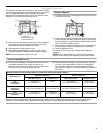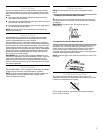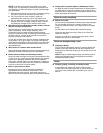
10
TROUBLESHOOTING
First try the solutions suggested here and possibly avoid the cost of a service call...
Dishwasher is not operating properly
■ Dishwasher does not run or stops during a cycle
Is the door closed tightly and latched?
Is the right cycle selected? Refer to the “Cycle Selections” in
the Consumer Reference Guide.
Is there power to the dishwasher? Has a household fuse
blown, or has a circuit breaker tripped? Replace the fuse or
reset the circuit breaker. If the problem continues, call an
electrician.
Has the motor stopped due to an overload? The motor
automatically resets itself within a few minutes. If it does not
restart, call for service.
Is the water shutoff valve (if installed) turned on?
It is normal for certain cycles to repeatedly pause for several
seconds during the main wash.
■ Clean light is flashing
The dishwasher has malfunctioned. Call for service to check
heater circuit.
■ Dishwasher will not fill
Is the overfill protection float able to move up and down
freely? Press down to release.
■ Dishwasher seems to run too long
Is the water supplied to the dishwasher hot enough? The
dishwasher runs longer while heating water. Refer to the
“Performance Tips” section.
A delay automatically occurs in some wash and rinse cycles
until the water reaches the proper temperature.
■ Water remains in the dishwasher
Is the cycle complete?
■ Detergent remains in the covered section of the dispenser
Is the cycle complete?
Is the detergent lump-free? Replace detergent if necessary.
■ White residue on the front of the access panel
Was too much detergent used? Refer to the “Detergent
Dispenser” section.
Is the brand of detergent making excess foam? Try a different
brand to reduce foaming and eliminate buildup.
■ Odor in the dishwasher
Are dishes washed only every 2 or 3 days? Run a rinse cycle
once or twice a day until you have a full load.
Does the dishwasher have a new plastic smell? Run a vinegar
rinse as described in “Spotting and filming on dishes” later in
this Troubleshooting guide.
■ Condensation on the kitchen counter (built-in models)
Is the dishwasher aligned with the countertop? Moisture from
the vent in the dishwasher console can form on the counter.
Refer to the Installation Instructions for more information.
Dishes are not completely clean
■ Food soil left on the dishes
Is the dishwasher loaded correctly? Refer to the “Loading”
section in the Consumer Reference Guide.
Did you choose the cycle that describes the most difficult soil
in your dishwasher? If you have some items with heavier soils,
use a heavier cycle.
Is the water temperature too low? For best dishwashing
results, water should be 120°F (49°C) as it enters the
dishwasher. Refer to the “Performance Tips” section.
Did you use the correct amount of fresh detergent? Use
recommended dishwasher detergents only. Refer to the
“Detergent Dispenser” section. Do not use less than 1 tb
(15 g) per load. Detergent must be fresh to be effective. Store
detergent in a cool, dry area. Heavy soil and/or hard water
generally require extra detergent.
Is detergent caked in dispenser? Use fresh detergent only. Do
not allow detergent to sit for several hours in a wet dispenser.
Clean dispenser when caked detergent is present.
Is the pump or spray arm clogged by labels from bottles and
cans?
Is the home water pressure high enough for proper
dishwasher filling? Home water pressure should be 20 to
120 psi (138 to 828 kPa) for proper dishwasher fill. If you have
questions about your water pressure, call a licensed, qualified
plumber.
Are high suds slowing the wash arm? Do not use soap or
laundry detergents. Use recommended dishwasher
detergents only.
Spots and stains on dishes
■ Spotting and filming on dishes
Is your water hard or is there a high mineral content in your
water? Conditioning the final rinse water with a liquid rinse aid
helps eliminate spotting and filming. Keep the rinse aid
dispenser filled. Always use a high-temp option. If your water
hardness is 13 grains or above, it is strongly recommended
that you install a home water softener. If you do not wish to
drink softened water, have the softener installed onto your hot
water supply.
Is the water temperature too low? For best dishwashing
results, water should be 120°F (49°C) as it enters the
dishwasher. Refer to the “Performance Tips” section.
Did you use the correct amount of effective detergent? Use
recommended dishwasher detergents only. Refer to the
“Detergent Dispenser” section. Do not use less than 1 tb
(15 g) per load. Detergent must be fresh to be effective. Store
detergent in a cool, dry area. Heavy soil and/or hard water
generally require extra detergent.
Is the home water pressure high enough for proper
dishwasher filling? Home water pressure should be 20 to
120 psi (138 to 828 kPa) for proper dishwasher fill. If you have
questions about your water pressure, call a licensed, qualified
plumber.


















